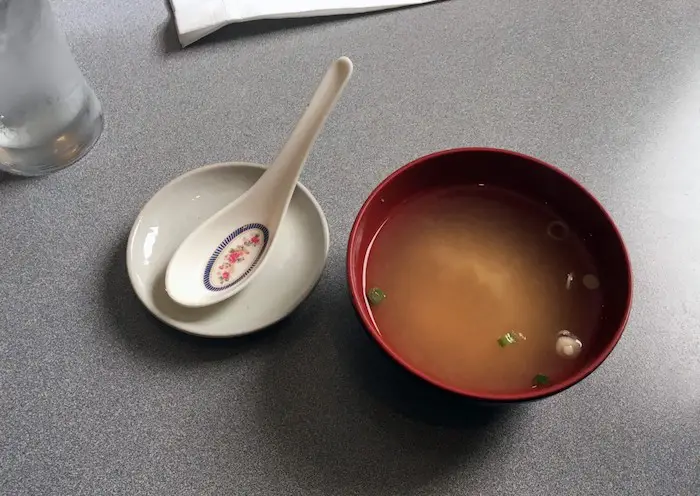We are reader supported. When you purchase through links on our site, we may earn an affiliate commission. Also, as an Amazon affiliate, we earn from qualifying purchases.

If you are looking to add an extra dash of umami flavor to your sushi meal, include miso soup. Whether you are trying miso for the first time or you wish to expand your range, this post will tell you all you need to know about miso soup, a key element in Japanese breakfast.
A common question people ask is ‘how to properly store miso soup?’ I would say let the soup cool down at room temperature and then transfer the content in an airtight jar and store inside the refrigerator for 2-3 days. You may also store miso soup in the freezer for up to 6 months.
Let’s admit that like many other foods, miso soup tastes best when it is eaten immediately. Refrigerating or freezing it for later use can reduce the texture and flavor. However, many people use miso soup as stock in preparing other dishes and prefer making large batches that can be refrigerated for later use.
When required, the frozen miso soup can be thawed to consume it in the way you prefer. Re-heating is fine but remember to not boil the soup as this may destroy the important enzymes.
Contents
Simple Miso Soup Recipe
Miso soup is one of those diverse dishes that can be prepared in many ways and numerous ingredients may be added as per the chef’s preference. It may be decorated with some complex garnishes to enhance the flavor. Remember that the ingredients you add to the soup can make or break it. Here’s a simple and quick recipe for the beginners:
What you will need:
- Half cup dried wakame (seaweed)
- 1/4 cup white miso paste like this
- 6 cups of dashi
- 1/2 pound soft tofu (sliced into ½ inch cubes)
- 1/4 cup finely sliced scallions
Instructions
To prepare wakame, mix the seaweed with warm water (make sure it submerges) and let it sit for about 15 minutes. Drain using a sieve.
Add dashi to a medium-size saucepan and put it on medium heat. Bring to boil and then reduce the heat
Take some warm water in a cup and whisk the white miso paste. Add the paste to the simmering dashi stock.
Add tofu slices and rehydrated wakame. Simmer for a minute and remove from heat. Garnish with finely chopped scallions before serving.
If you are too lazy to make it, you can use instant tofu miso soup like this. Just simply mix contents of one single-serve packet in a bowl with 2/3 cup boiling water for instant soup.
3 Types Of Miso Paste Used For Making Miso Soup
There are three different varieties of miso paste used for making the umami filled miso soup. They can slightly change the overall flavor of the soup, so here’s what you need to know:
1.White Miso
Known as Shiro miso in Japanese, it is often referred to as ‘mellow’ or ‘sweet’. This type of miso paste is fermented for a short period and has a lower salt content than the darker ones. The soup has a mild and delicate flavor that can be easily adapted. It works great with summer soups, dressings, and light sauces. They may also be used as a substitute for dairy products for those who are lactose intolerant.
2. Yellow Miso
In Japanese, it is called Shinshu Miso, another type of miso paste that has a mild flavor. It is fermented slightly more than the white miso. The color may range between light yellow miso to slightly brownish undertones due to change in salt level. It can be easily used in different types of soups and glazes.
3. Red Miso
Known as Aka miso (see Amazon) in Japanese, this type of miso paste is fermented for really long to get that dark red and brown shades. The red miso is saltier than the yellow versions, and they have a more dominating and pungent flavor. It works great for marinades, glazes, braises, and soups. However, it can easily overpower mild flavors so use carefully.
Different Ways Of Using Miso Soup
This delicious soup can be a light snack in itself or a tasty accompaniment to a sushi meal. It is often considered as a pre-appetizer in many Japanese-American restaurants, served in small bowls before the main course.
However, this flavorful stock comprising of miso paste and tofu is not just limited to being a breakfast item, an appetizer or side dish. You can enrich your miso soup with different types of vegetables and seafood to create a filling meal.
Add finely sliced or chopped vegetables such as onions, carrots, leafy greens, and eggplant to your miso soup to make a tasty meal. Here are some suggestions:
- Shitake mushrooms can add a burst of rich flavor and aroma
- Create a unique blend of flavor by mixing seaweeds like wakame
- Enhance the flavor by adding leeks, shallots, and Japanese ginger
- Include Chinese dumplings to turn your soup into a filling meal
- If you are a seafood lover, throw in some shrimps and clams
Tips To Properly Store Miso Soup

When storing miso soup in a refrigerator, put it in a sealed and airtight container so that the content can be fresh and free of any bacterial contamination. It should be consumed within 2-3 days of cooking and refrigerating it. If you wish to re-heat the refrigerated miso soup, you may do so on a stove or microwave but don’t bring it to boiling point.
If you made a large batch of miso soup and wish to keep it ready-to-use in any recipe for months, consider freezing it instead. To properly freeze miso soup, you should pour it into a container that seals well in order to avoid or minimize freezer burn.
I suggest not filling the containers up to the brim but leave an inch gap for the liquid to expand. Seal the lid well to retain the flavor and put inside the coldest area of the freezer to store it for up to 6 months.
If you wish to use miso soup as a base broth to add as an ingredient to other dishes, consider freezing it into ice cubes. Store these cubes in a freezer-safe bag so that you can thaw and use only as much needed without wasting any of it.
Ways To Thaw Frozen Miso Soup Correctly
Most people prefer making large batches of miso soup that they can use as stock in various dishes. Now that you know how to properly store miso soup, you will also need to thaw the frozen soup correctly. There are quite a few options available, so you may choose the one that suits you.
The refrigerator method
To thaw frozen miso soup before using it in any recipe, put the frozen container inside the refrigerator and let it sit overnight. Sometimes it might take an entire day for the frozen content to thaw completely. Use the soup within 1-2 days after it is thawed completely. Refreezing is not recommended as this may change the flavor and taste.
Re-heating in a stove
When in a hurry, you can thaw frozen miso soup by reheating the content in a saucepan over medium heat. Wait until it reaches a temperature of 165 degrees Fahrenheit to be completely thawed. Once the soup is liquid again and back to room temperature, don’t refreeze it or the flavor will be lost.
Running under cold water
Put the jar containing frozen miso soup in a large bowl and place it in your kitchen sink. Now, fill the bowl with cold water. Ensure that the jar or plastic bag containing frozen soup is completely submerged. Adjust the faucet in a way that cold water keeps running over the frozen soup in a smooth way instead of rushing out. It may take an hour or more for the soup to thaw completely. Use it all because the soup can’t be refrozen after using this method.
Heating In A Microwave
Put the frozen soup packet in a microwave-safe bowl and make a few slits on it for ventilation. If you are using a jar, make sure the lid is microwave-safe or else remove it. Adjust the microwave settings to ‘defrost’ or simply ‘low’ settings and run for just 1-2 minutes.
If you need to heat more, give intervals after every 1-2 minutes of heating or else you may burn the soup. Once the content is thawed completely, consume it within a day or two.
7 Common Mistakes You Must Avoid With Miso Soup
Preparing miso soup at home and storing it is pretty simple. You just need a handful of ingredients to create the basic stock. Despite being a simple process, there are some common mistakes beginners commit when making the soup for the first time.
1. Using low-quality miso
If you want a great tasting miso soup, you will need to invest in high-quality miso paste. After all, you get what you pay for. Bear in mind that this preparation has very few ingredients so that the quality of each one matters a lot. Look for authentic miso paste that has been prepared according to Japanese technique. A small packet can last for long so don’t worry much about the price.
2. Adding miso paste to the boiling broth
Just like yogurt, miso is also a type of fermented food that contains live bacteria (the good ones). However, adding it to a boiling broth will kill the probiotics and destroy the health benefits of miso. Wait until the soup cools down a bit before you whisk in the miso paste. The paste will melt into the soup to give it a cream-like texture.
3. Mixing miso paste directly to the soup
This is another no-no because if you add the miso paste directly to the soup, you will get lumpy formations. The right way to do this is to mix the paste to a small amount of warm water until it dissolves completely. The ratio should be 1 tablespoon of miso paste to 1.5 cups of warm water.
4. Wrong type of tofu
Tofu comes in different varieties and not all of them are perfect for miso soup. You must only get the soft and silky ones for soup and keep the firm ones for stir-fries. The silky soft tofu melts into the soup, giving it a nice thick and creamy consistency.
5. Canned stock bought from stores
The grocery store-bought stock may be good enough for the average chicken soup, but miso soup is a specialty that demands something more. If you want your miso soup to taste restaurant-like, make your own dashi using seaweed or kombu.
6. Sautéing vegetables
If you wish to add vegetables to enhance the flavor and thicken the texture of your soup, avoid sautéing them. That style of cooking involves oil that can lend a greasy texture to your soup. Finely slice the vegetables so that they soften quickly when added to the soup. Garnishes such as scallions, chives, and spring onions should be added just before serving or else they will lose their fresh aroma.
7. Not serving immediately
Miso soup is supposed to be eaten immediately after it’s prepared but if you let it cool down completely, the ingredients will settle at the bottom. Stir the soup with chopsticks if it had been sitting out for a long time. While it’s okay to store miso soup, it will not taste as fresh.
Related Questions
Why you should not boil thawed miso soup?
You can reheat miso soup but avoid boiling it to extreme temperature as this will destroy some of the useful enzymes. Even when you reheat, don’t treat it with high temperatures.
What’s the right way to store miso paste?
A packet of store-bought miso paste can last really long, so store the remaining paste in a tightly sealed container and keep inside a refrigerator. Remember to check the expiry date on the package and stay away from brands that contain additives such as MSG. It can last for up to 9 months if stored properly.
Is it safe to drink miso soup in pregnancy?
Yes, miso soup comprises of miso paste that is made from fermented soybeans. It is absolutely fine to eat soy products in pregnancy as long as they are a part of your balanced diet.


